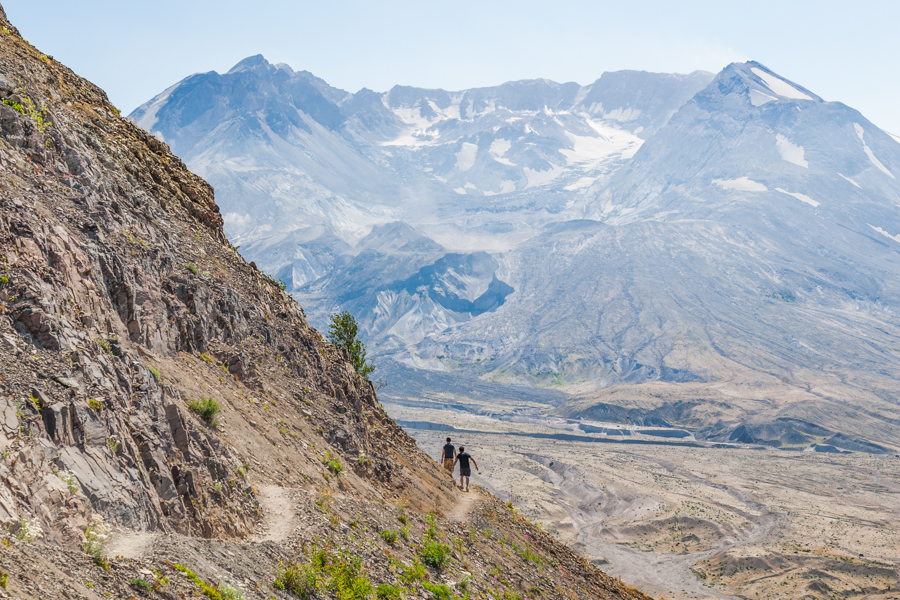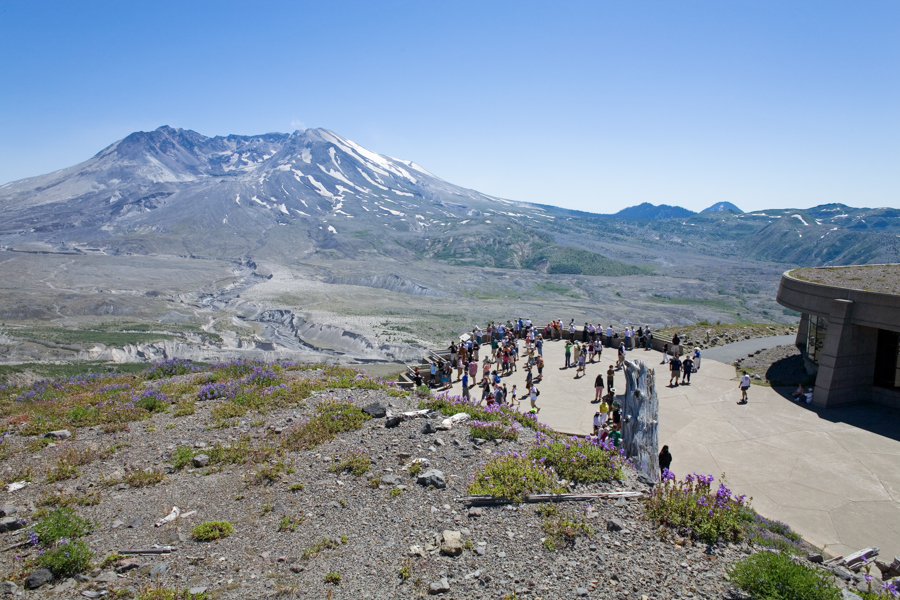Mt St Helens
Mt St Helens has the distinction of being the only volcano in the contiguous 48 states to erupt in modern times, qualifying it as the second wonder of Washington. When the north side of the mountain collapsed it created the largest landslide in recorded history. The debris mudflow (or lahar) reached all the way to the Columbia River, 17 miles away, and was 600 feet deep in places. Mt St Helens lost 1300 feet of elevation and its symmetrical cone was replaced by a crater 2 miles wide. The ash plume reached 15 miles high and ash could be seen on cars as far away as South Dakota (I witnessed this myself). The eruption on May 18, 1980 destroyed 185 miles of roads, 47 bridges, 250 homes, wiped out hundreds of square miles of forest and killed 57 people.
Following the 1980 cataclysmic eruption, 21 much smaller eruptions occurred over the next six years, and during this time period Mt St Helens began rebuilding itself. A lava dome appeared that was formed as hardened lava was extruded from the crater floor. Beginning in 1987 the volcano was relatively quiet and then began another series of small eruptions and dome building from 2004 to 2008. Magma reached the crater and could be seen glowing red through the cracks in the lava dome. Mt St Helens is currently in another quiet phase, but occasionally visitors can still see steam venting from the dome.
In 1982 the Mt St Helens National Volcanic Monument was established and in 1997 the Johnston Ridge Observatory opened. It was built near the spot where volcanologist David Johnston witnessed the eruption from about five miles away. He was in radio contact with the USGS Vancouver office when Mt St Helens blew, and told them, "Vancouver! Vancouver! This is it!" David was instrumental in getting the area surrounding Mt St Helens closed off to the public prior to the eruption, despite pressure to keep it open, and this undoubtedly saved hundreds of lives. His body was never found. Today visitors have the opportunity to explore the blast zone around Mt St Helens first hand through a network of trails, guided walks and presentations by volunteers.
The story of Mt St Helens is not just about death and destruction. It is also about recovery. Although it will take centuries for the old growth forests to re-establish themselves, naturalists are surprised at how quickly nature has started to reclaim the devastated landscape. Among the first plants to arrive was the Prairie Lupine, which can absorb nitrogen directly from the air instead of the ground. These wildflowers attracted insects and plant eating animals.
The photographs and information about Mt St Helens shown here are just a sample from the book, The Seven Wonders of Washington State, which is available on Amazon.com.
The photographs and information about Mt St Helens shown here are just a sample from the book, The Seven Wonders of Washington State, which is available on Amazon.com.
Experiencing Mt St Helens
Mt St Helen National Volcanic Monument Entrance Cost: none
Johnston Ridge Observatory Use Fee: $8
Mt St Helens Visitor Center (at Silver Lake) Admission: $5 - $15
Access: roads are closed in the winter, Johnston Ridge Observatory is normally open June through October, Mt St Helens Visitor Center is open year round
Mt St Helen National Volcanic Monument Entrance Cost: none
Johnston Ridge Observatory Use Fee: $8
Mt St Helens Visitor Center (at Silver Lake) Admission: $5 - $15
Access: roads are closed in the winter, Johnston Ridge Observatory is normally open June through October, Mt St Helens Visitor Center is open year round
You can see more photographs of Mt St Helens and purchase fine art prints at WashingtonPhotographs.com.
Mt St Helens Online Resources
A Riveting View of Mt St Helens
Gifford Pinchot National Forest
LiveScience.com - Mt St Helens Still Recovering 30 Years Later
MtStHelens.com
Mt St Helens Institute
Mt St Helens National Volcanic Monument
Mt St Helens Photographs
Mt St Helens Visitor Center
Pacific Northwest Seismic Network - Mt St Helens
USGS Volcano Hazards Program - The Legacy of David A Johnston
USGS Volcano Hazards Program - Mt St Helens
Washington Trails Association - Mt St Helens Hikes
Mt St Helens Online Resources
A Riveting View of Mt St Helens
Gifford Pinchot National Forest
LiveScience.com - Mt St Helens Still Recovering 30 Years Later
MtStHelens.com
Mt St Helens Institute
Mt St Helens National Volcanic Monument
Mt St Helens Photographs
Mt St Helens Visitor Center
Pacific Northwest Seismic Network - Mt St Helens
USGS Volcano Hazards Program - The Legacy of David A Johnston
USGS Volcano Hazards Program - Mt St Helens
Washington Trails Association - Mt St Helens Hikes
Photographer Howard Frisk and musician Larry Merritt have teamed up to create a unique offer. Larry has created a special edition of his music CD, The Seven Wonders of Washington State, as a companion CD to Howard's book by the same title. The CD includes seven original instrumental songs written and performed by Larry, one for each of the seven wonders of Washington State. You can listen to the first track of the CD below and purchase the book with or without the CD via the Buy Now link below.



